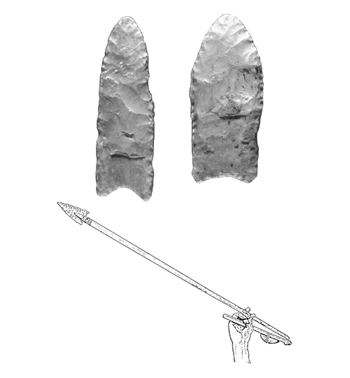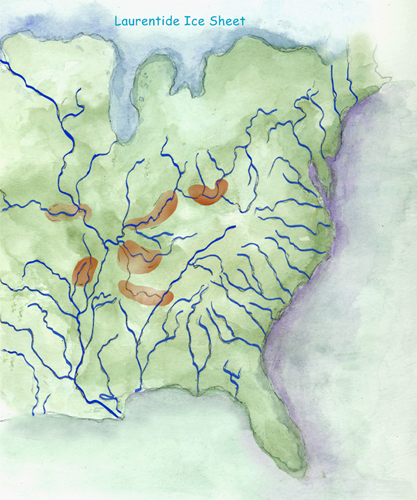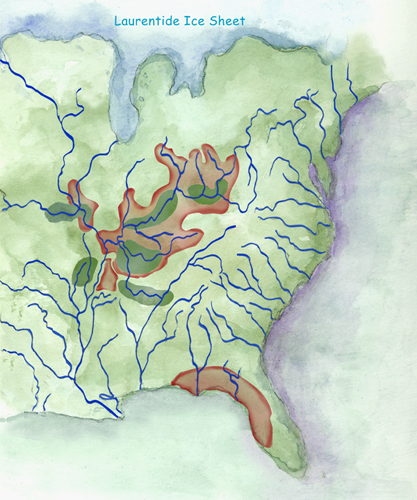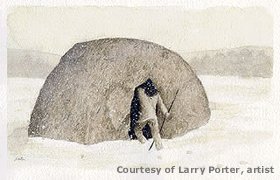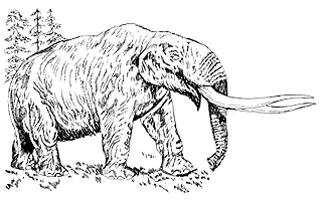Paleoindians: Ice Age Hunters in Arkansas
and the Mid-South 11,500-8500 B.C. by George Sabo III
Clovis points are found in Canada, the United States, and Mexico. Many Clovis sites also contain the remains of large Ice Age mammals, including mammoths and mastodons. Clovis sites are radiocarbon dated between 11,500 and 10,500 B.C.
J. Christopher Gillam studied the distribution of Clovis artifacts in Arkansas. Most Clovis material occurs in the eastern part of the state, indicating that the first groups migrated down the Mississippi River from the northern plains. Radiocarbon-dated sites in Missouri, Oklahoma, and Tennessee place the Clovis arrival in the Mid-South around 10,500 B.C. Clovis points are not evenly distributed; rather, they occur in regional clusters that archeologists interpret as “staging areas.” Staging areas are the localities where Paleoindian migrations halted and groups began to settle down and make adaptations—that is, changes in their routines—in relation to regional environments.
Archeologist Juliet Morrow studies the regional variants of Clovis points that developed in and around mid-South staging areas. She believes the appearance of these variants represents the emergence of regionally distinctive Paleoindian groups. These groups maintained their mobile way of life, but instead of migrating across a wide, uninhabited terrain, they now moved within specific territories they considered their home. Groups periodically branched out to occupy new territories in adjacent regions.
Ancient peoples’ views of the world can sometimes be inferred by studying their artworks. Unfortunately, very few Paleoindian artworks have been found. A few pieces of bone, ivory, and stone found at several Paleoindian sites across North America are inscribed with geometric designs that are difficult if not impossible to interpret. A zigzag “lightning bolt” drawn with red ochre (a form of iron oxide) on the skull of a bison killed by late Paleoindian hunters in Oklahoma is interpreted by archeologist Lee Bement as evidence of hunting ritual. These tantalizing examples don’t shed a great deal of light on specific Paleoindian beliefs, but they demonstrate a capacity for symbolic communication that later Indian groups used extensively. When Clovis people reached the Mid-South, upland areas in what is now Arkansas were covered by patches of tundra, grassland, and boreal forest. Bottomlands supported mixed deciduous forests. There were few edible plant foods, but large Ice Age mammals including mammoths and mastodons roamed grasslands and open woodlands and caribou grazed scattered tundra zones. This mixture of closely-spaced tundra, boreal forest, hardwood forest, and grassland habitats no longer exists anywhere in the world. Another unique feature of Ice Age environments is that there were no marked seasonal changes – it was mostly cold and wet the year-round. The Mississippi River flowed in multiple, braided channels within a vast expanse of gravel bars. Water from melting glaciers was too cold and turbulent to support fish or shellfish.
Many Ice Age species, including mammoths and mastodons, suffered extinction before 8000 B.C. Archeologists and paleontologists debate whether these extinctions were caused by climate change, human hunting, disease, or some combination of factors. Recent studies of the impacts of climate changes on vegetation suggest that the grassland and open woodland habitats favored by mammoths and mastodons shrank dramatically towards the end of the last Ice Age. As dwindling herds became increasingly confined to shrinking habitats, Clovis hunting could have been a significant tipping point on the path to extinction. The elimination of mammoths and mastodons forced Clovis people to alter their hunting strategies. Deer, elk, and bison—already present when Paleoindians entered the Southeast—became the primary game animals. Deer and elk are solitary wanderers adapted to forest edge habitats so their pursuit required different tracking strategies and hunting techniques. As the Clovis people adapted, a new way of life emerged that archeologists call the Dalton Culture.
|
||||||||||
 |

|
